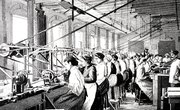In 1381, peasants in the English countryside assembled into a ragtag army of men and women and marched on London. If any group in Medieval Europe had cause to revolt, it would have been the peasantry, particularly the women. Bound by feudal law to rural villages, peasant women knew an existence that was unthinkable by today's standards. Theirs was a life of constant toil, punctuated by a number of harsh realities. These included unsanitary living conditions, risky pregnancies and poor nutrition. Conditions eventually improved for village women, but only after the Black Death increased the value of their labor and hastened the end of serfdom.
Domestic Life
For a village woman, life as a wife and mother began in her teenage years, when most women exchanged vows. Once established in the home, her primary duties became housekeeping and child rearing. It was a difficult lot, to be sure. There was clothing to wash, food to make, wool to spin and floors to sweep. The cooking fire burning in the center of the house all day made the home warm and smoky. The livestock living under the same roof as the family left unpleasant odors to contend with. A clean house was difficult to keep when children and animals constantly trekked back and forth across the earthen floor.
Feudal Labors
A village woman's work was not limited to the household. She was also expected to help tend the land. Harvest time often found her in the fields, gathering crops alongside her husband. She was also responsible for looking after livestock. A peasant family might earn extra income by providing necessary goods and services. Women helped out here as well. A housewife might spin wool, brew ale or bake bread. In part, the justification for such a heavy workload came from Catholic tradition, which equated women with Eve and blamed them for humanity's downfall.
Health and Nutrition
Life expectancy was low for Europe's peasantry in general, but women faced additional dangers in childbirth. It was so risky, in fact, that midwives had official sanction to baptize dying infants. Sometimes a Caesarean was necessary, almost always resulting in the mother's death. But not every village even had a midwife. Medical care was often spotty in rural areas. It did not help that food was scarce in winter and that there were deadly famines throughout the 1300s. Factor in the Black Death, which struck in the 1340s, and it is easy to see why average life expectancy was only 45.
Religion and Tradition
Europe's peasantry lived and died under the authority of the Church. Priests officiated at weddings, baptisms and funerals. Though the Church justified women's lowly position with references to Eve, it also gave them more than 50 holidays a year. Indeed, many of these were set aside strictly for women. However much the Church despised Eve, it could not ignore the fact that Mary had also been a woman. Yet just how much of this peasant women understood remains unclear. Most peasants were uneducated and would not have understood a rote mass recited in Latin by a village priest who was also illiterate.
The End of Serfdom
By the late 1300s, the old feudal order was on the wane. Following the 1381 peasant uprising, King Richard II swore to abolish serfdom altogether. The fact that he later went back on his promise was of little importance. By that point, the Black Death had made feudal laborers more valuable by drastically reducing their numbers. Village women now became upwardly mobile, able to command considerable wages for themselves. But by this point, the Middle Ages were coming to a close, and women everywhere were transitioning into a new phase of their history.
Related Articles
References
Resources
Writer Bio
A longtime author of lifestyle articles, Gregg Newby has written extensively on personal finance, health and wellness, fitness, education, and more. His work has been syndicated by several major news websites, including FOX, CBS, and Accuweather. Newby holds a master's degree in history and is an ardent pluviophile.











